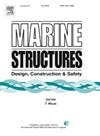基于概率的研究,探讨土壤强度空间变化的影响,研究承受第三方冲击荷载的埋地海上管道的失效机理和定量风险分析
IF 4
2区 工程技术
Q1 ENGINEERING, CIVIL
引用次数: 0
摘要
埋设是保护近海管道免受冲击载荷的有效方法。然而,很少有研究涉及土壤固有的空间变化对土壤覆盖层和管道破坏行为的影响,从而导致偏差。因此,本文建立了一个随机场-大变形有限元分析框架,以探讨埋地管道在空间变化土壤中的破坏机制。土壤覆盖层的破坏模式符合局部模式,破坏路径对土壤变化不敏感。管道的破坏机制取决于土壤强度之间的竞争机制和管道与土壤之间的相互作用,在此基础上总结出两种典型的破坏模式。土壤的多变性不仅会加剧冲击破坏,还会刺激结构响应的多样性。讨论了概率破坏程度与多种影响因素之间的相关性。此外,在能量耗散原理的启发下,得出了一个综合定量风险评估模型,以揭示破坏风险的演变,其中考虑了土壤变异和结构相关因素的不确定性。后者具有重大影响,可能造成超过 50% 的额外失效概率。比较了不同的安全设计方法,并为确定埋深配置了空间失效概率曲面。本文章由计算机程序翻译,如有差异,请以英文原文为准。
A probability-based study on failure mechanism and quantitative risk analysis for buried offshore pipelines subjected to third-party impact loads, exploring the effects of spatial variability of soil strength
Burial is an effective approach to offshore pipeline protection for impact loads. However, few studies address the influences of inherent soil spatial variabilities on failure behaviour of soil covers and pipelines, causing deviations. Therefore, a random field-large deformation finite element analysis framework is developed to explore the failure mechanisms of buried pipelines in spatially varying soils. The failure mode of soil cover is conformed to a local mode, where the failure path is insensitive to soil variability. The failure mechanism of pipelines depends on the competition mechanism between soil strengths and pipe-soil interactions, based on which two typical failure modes are summarized. Soil variability not only aggravates the impact damage but also stimulates the diversity of structural responses. Correlations between probabilistic damage degrees and multiple influential factors are discussed. Further, inspired by the principle of energy dissipation, an integrated quantitative risk assessment model is derived to reveal the failure risk evolution, where uncertainties from soil variabilities and structure-related factors are considered. The latter shows a significant influence, which may pose an additional failure probability of over 50 %. Different safety design approaches are compared, and spatial failure probability surfaces are configured for burial depth determination.
求助全文
通过发布文献求助,成功后即可免费获取论文全文。
去求助
来源期刊

Marine Structures
工程技术-工程:海洋
CiteScore
8.70
自引率
7.70%
发文量
157
审稿时长
6.4 months
期刊介绍:
This journal aims to provide a medium for presentation and discussion of the latest developments in research, design, fabrication and in-service experience relating to marine structures, i.e., all structures of steel, concrete, light alloy or composite construction having an interface with the sea, including ships, fixed and mobile offshore platforms, submarine and submersibles, pipelines, subsea systems for shallow and deep ocean operations and coastal structures such as piers.
 求助内容:
求助内容: 应助结果提醒方式:
应助结果提醒方式:


